James Montgomery Flagg
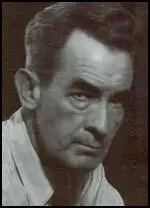
James Montgomery Flagg was born in New York City on 18th June, 1877. He had a difficult relationship with his parents. he later wrote: "Loyalty to family as such doesn't seem to me pertinent. Family isn't sacrosanct to me. To hell with the snobbery of inheritance."
Flagg was a talented artist and when he was twelve years old he sold his first illustration to St. Nicholas for $10. The Century Magazine later reported that the editor recalled: "There was something in those easy, unstudied lines that breathed ability and capacity so great that words of praise and encouragement seemed only a duty."
By the age of fourteen he was a member of staff of the humorous Life Magazine. His work was greatly admired by the industry and two years later he was working for Judge, the most popular magazine in this field. In 1893 Flagg went to the Art Students League. Although he made some very good friends at the art school, such as John Wolcott Adams and Walter Appleton Clark, he was disappointed about his development as an artist.
Art Student
In 1897 he visited London with his friend, Richmond Kimbrough. He also attended the art school run by Hubert von Herkomer. He later recalled: "There are no art teachers. Art cannot be taught. Artists are born that way. They educate themselves, or else they do not become educated... I happen to have been born an artist. Ask anyone who doesn't know. I wasted six years of my young life in art schools. As far as any benefit accruing to me from them - I was working on the outside all the time, anyway. Nothing but total disability or death could have stopped me. I had to be an artist - I was born that way... You can't breed an artist. You can only breed mediocrity."
Flagg's main artistic heroes during this period were Howard Pyle and John Singer Sargent. However, he disliked the artist when he met him: "Sargent was more English than the English; in fact, not to be too refined about it, his manner was snotty." This experience did not stop Flagg from admiring Sargent's artistic gifts."
On his return to the United States he married Nellie McCormick, a woman eleven years senior. Flagg pointed out in his autobiography: "Here was the beautiful woman who had turned down a number of rich suitors to marry a poor but promising artist who was madly in love with her.... Nellie was a St. Louis socialite and knew all the richest people in all the big cities; up to then a realm of society entirely beyond my knowledge. In the early days of our marriage when I was short of cash, she put her allowance at my disposal in an utterly generous and unselfish way."
James Montgomery Flagg - Artist
The couple lived in various homes in California, Florida and Virginia. For the next few years Flagg attempted to become a portrait painter. This was an unsuccessful venture and in 1904 he leased a studio apartment in New York City and decided to concentrate on his magazine work. His work appeared in all the major publications, including Scribner's Magazine, Judge, McClure's Magazine, Collier's Weekly, Ladies' Home Journal, Cosmopolitan, Saturday Evening Post and Harper's Weekly.
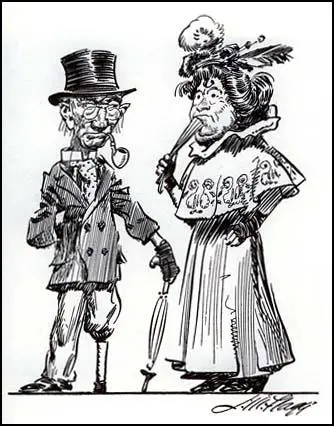
His biographer, Susan E. Meyer, has argued: "He (Flagg) received so many assignments that he claimed to have averaged an illustration a day for years - and the quantity of his work reproduced during this time (as well as his earnings) substantiates the accuracy of this estimate. Flagg was not only a productive illustrator, he was also enormously versatile.. Flagg displayed his powers in opaque and transparent watercolor and oils. He worked in monochrome for halftone reproduction; with a full palette for color reproduction. He was equally skilled in charcoal and pencil. He was even a consummate sculptor. No medium was too difficult for him and except for pastel (which he disliked) he used them all with ease."
In 1903 he began drawing portraits of Hollywood stars for Photoplay Magazine. Flagg had sexual relationships with several of these women. He later recalled: "Many of those girls were so beautiful; and artists are such fools! If I had this side of life to live over again. I'd again be just such a fool as I was!" Flagg rejected the idea that these were "love affairs". He thought a "lust affair" was a better description.
While in Hollywood he became friends with John Barrymore: "A great scholar, a great actor, a great occultist, a great drinker, a great swordsman, a great conversationalist, a great companion, a great wit and a great gent... I want to underline the fact that in spite of Jack's drinking, he had something that transcended the obvious weakness, that shone through the unhappy fumes like a sunrise through mist. People who loved him know that."
Flagg remained close friends with Walter Appleton Clark until his early death. "I loved and admired Walter; a grand human and a great artist... to my mind he was second only to Howard Pyle as America's number one illustrator... It seems fantastic that today he is unknown except by some of the old-timers who still recognize that no artist now living is his superior."
First World War
When the United States became involved in the First World War a group of artists, with Charles Dana Gibson, as chairman, established the Division of Pictorial Publicity. The group met once a week at Keene's Chop House in New York City, to discuss the government's requests for posters. During this period, Flagg designed 46 posters. This included the famous Uncle Sam poster with the caption "I Want You for the U.S. Army".
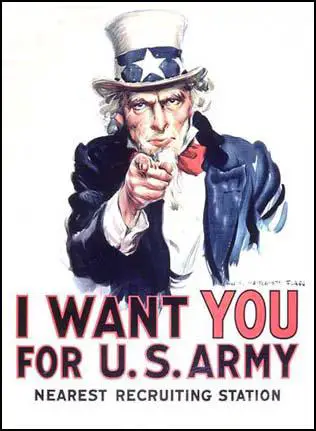
Nellie McCormick Flagg died in 1923. He married one of his models, Dorothy Virginia Wadman, the following year. His daughter, Faith, was born in 1925. Flagg claimed the marriage was the "worst mistake of my life". Susan E. Meyer points out: "Flagg was already 48 years old when his daughter was born. His lifestyle was not ideally suited for paternity, but within his limitations he attempted to make the best life for her he could." Dorothy Flagg suffered a severe psychiatric breakdown a few years after the birth of her daughter and was Institutionalized.
Flagg was a strong supporter of Franklin D. Roosevelt and the New Deal and painted presidential election posters for him. The author of James Montgomery Flagg (1974) has commented: "Flagg had always admired FDR in public life and was equally impressed with the man in person, for he was not only forthright (a quality Flagg particularly respected in people), but he had a sense of humor as well."
James Montgomery Flagg & Hollywood
Flagg continued to work for Photoplay Magazine. He painted the portraits of all the major filmstars. The actresses he considered the most beautiful included Hedy LaMarr ("it would be only a blind and deaf man who wouldn't fall in love with her"), Joan Fontaine ("she has everything"), Greta Garbo (I can think of no woman I would prefer to paint") and Merle Oberon ("much more beautiful to meet than to see... on the screen").
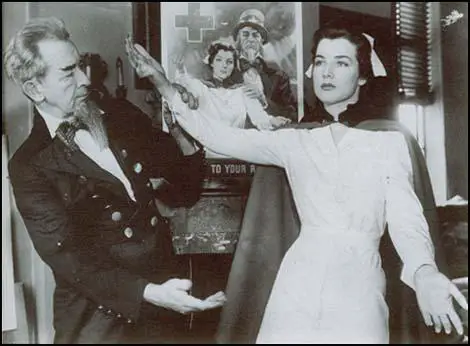
During the Second World War Flagg once again offered his services to the government and produced a large number of patriotic posters. Flagg was himself the model for Uncle Sam. He also painted several posters for the Red Cross. This included his favorite model of the time, Georgia McDonald.
Flagg had a long-term relationship with another one of his models, Ilse Hoffmann, the daughter of Hans Heinrich Lammers. His biographer has argued: ""Half Flagg's age, Isle was a complex and unhappy woman. Enraptured with her beauty, Flagg felt perpetually compelled to paint her, in spite of her being a poor model because she hated to pose. He was dazzled by her physical grace, her humor and intelligence, by her good taste and her coquettish manner." He described her as the great love of his life and was devastated when she committed suicide in 1945.
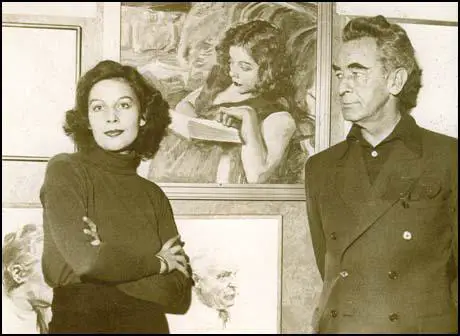
In 1946 he published his autobiography, Roses and Buckshot. He wrote: "If people were honest, which few are... love, while it begins with physical desire and passion, is more, much more, than that. It is a matter of growth, of quality, of strong sympathy, of shared troubles and joys. In other words, a roll in the bed with honey isn't love! And the tragic part of it is that you never learn this until you're past the age for it to happen to you again."
Easel Painter
Flagg was a talented easel painter and in 1948 he held a one-man exhibition at Ferargil Gallery in New York City. However, he was dismissive of modern art: "It's silly to speak of modern art. There's no such thing. Art is good or bad, time has nothing to do with it." He dismissed Paul Cézanne and Vincent Van Gogh as charlatans and described the work of Pablo Picasso as "kin to the nasty scrawls chalked on an alley wall by underprivileged monster boys". Flagg added: "The difference between an artist and an illustrator is that the latter knows how to draw, eats three square meals a day and can pay for them."
In the 1950s magazines preferred to use photographs than illustrators like Flagg. He wrote: "I hate old age like a flower cut off from life and wilting, even the recall of a gay past gives an unbeautiful picture and a nauseating smell.... All my life I have been a worshipper of that beauty of human form you see in some men and women. All my life I have been a worshipper of that beauty of human form you see in some men and women. All my life I have associated with the clever and witty, the brains you find in some people. Is it any wonder I don't like to look at the physical mess and mental dullness that has set in for me? As far back as I can remember, I've been in the limelight; now I'd rather be dead than be passed by, ignored."
James Montgomery Flagg died three weeks before his 83rd birthday on 27th May, 1960.
Primary Sources
(1) The Century Magazine (June, 1915)
The year 1890 beheld the artist J. M. Flagg about to enter the art world and his teens. In March of that year, on a Saturday afternoon, Jimmy Flagg, armed only with a few pencil sketches he had made in Central Park, overcame a boy's awe of the editorial Olympians, and presented himself in the office of St. Nicholas and asked to see one of the editors. The writer of these lines was told to receive the young caller, and after a few words set himself to examine the boy's drawings.
There was something in those easy, unstudied lines that breathed ability and capacity so great that words of praise and encouragement seemed only a duty. They were strong and sincere words, and, as Mr. Flagg said recently, sent him away "walking on air."
The editorial praise was duly reported at home, and led to another visit from the young artist, this time to ask if the editor would repeat to the boy's mother the praise already given to the boy's work. And soon afterward came the mother, to whom even more was said than could be properly put in talking to a boy of twelve -- something of what unusual promise for the future seemed to be in the sketches shown. A plea was made that the rarity of the boy's gift entitled him to give his life to art work. The plea was the stronger that it came from one who in boyhood had wished to be an artist, and who to this day regrets that the wish was never carried out.
An invitation to visit the boy's father was given, and within a few days the writer found himself invited to dine and afterward to take part in a family council. It was not a matter of combating parental opposition, but of strengthening parental faith, and changing passive willingness into an active purpose to further a wise ambition.
After that talk, Mr. Flagg's visits to the editorial office became frequent, and the young illustrator was always assured of a warm welcome and of a keen interest in his work, some of which the magazine published, though of course the drawings of that time had in them more of promise than of fulfillment.
Art teaching was sought, and the native skill was trained and developed chiefly under the wise guidance of the Art Students' League, where the artist was able to prove his ability in competition with his fellows. In the outer world also was found a demand for the forceful pencil of the capable student, and before long frequent checks proved that even from the commercial point of view an art career was to be worth while.
(2) Cathy O'Brien, James Montgomery Flagg's granddaughter, wrote in April 2001 about the background to his famous war poster.
James Montgomery Flagg first painted his famous Uncle Sam for a 4th of July 1916 issue of Leslie's Magazine. He was commissioned by the magazine in 1914, and reluctantly agreed when he finally saw what he believed to be the perfect model, a young soldier on a train.
Upon our involvement in WWI, the government contacted Flagg, requesting him to adapt his infamous figure into a war poster, and the rest is history.
He did not pose for this particular poster, but by the time WWII broke out, he was beginning to resemble his painting more and more. Flagg posed for many of his WWII posters, saving the cost of "model hire".
(3) James Montgomery Flagg, New York Herald Tribune (9th September, 1938)
There are no art teachers. Art cannot be taught. Artists are born that way. They educate themselves, or else they do not become educated... I happen to have been born an artist. Ask anyone who doesn't know. I wasted six years of my young life in art schools. As far as any benefit accruing to me from them - I was working on the outside all the time, anyway. Nothing but total disability or death could have stopped me. I had to be an artist - I was born that way... You can't breed an artist. You can only breed mediocrity.
(4) Susan E. Meyer, James Montgomery Flagg (1974)
There are no art teachers. Art cannot be taught. Artists are born that way. They educate themselves, or else they do not become educated... I happen to have been born an artist. Ask anyone who doesn't know. I wasted six years of my young life in art schools. As far as any benefit accruing to me from them - I was working on the outside all the time, anyway. Nothing but total disability or death could have stopped me. I had to be an artist - I was born that way... You can't breed an artist. You can only breed mediocrity.
(5) James Montgomery Flagg, Roses and Buckshot (1946)
If people were honest, which few are... love, while it begins with physical desire and passion, is more, much more, than that. It is a matter of growth, of quality, of strong sympathy, of shared troubles and joys. In other words, a roll in the bed with honey isn't love! And the tragic part of it is that you never learn this until you're past the age for it to happen to you again...
I hate old age like a flower cut off from life and wilting, even the recall of a gay past gives an unbeautiful picture and a nauseating smell.... All my life I have been a worshipper of that beauty of human form you see in some men and women. All my life I have been a worshipper of that beauty of human form you see in some men and women. All my life I have associated with the clever and witty, the brains you find in some people. Is it any wonder I don't like to look at the physical mess and mental dullness that has set in for me? As far back as I can remember, I've been in the limelight; now I'd rather be dead than be passed by, ignored.
Student Activities
American Artists and the First World War (Answer Commentary)
Käthe Kollwitz: German Artist in the First World War (Answer Commentary)
Walter Tull: Britain's First Black Officer (Answer Commentary)
